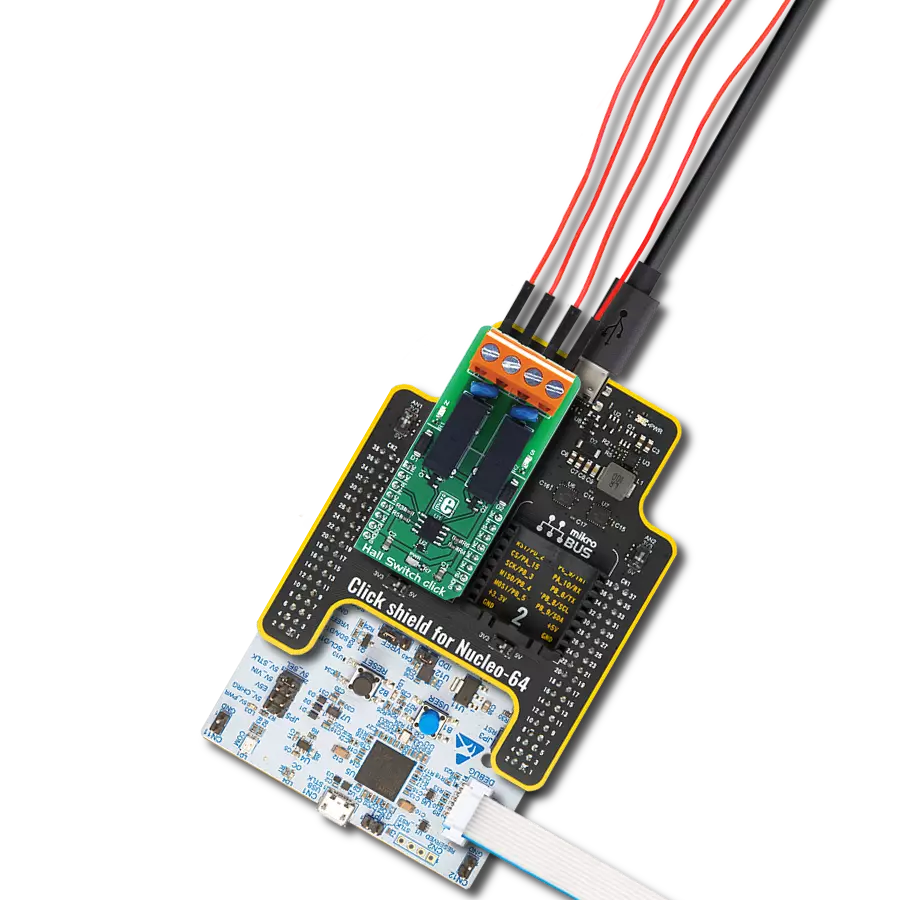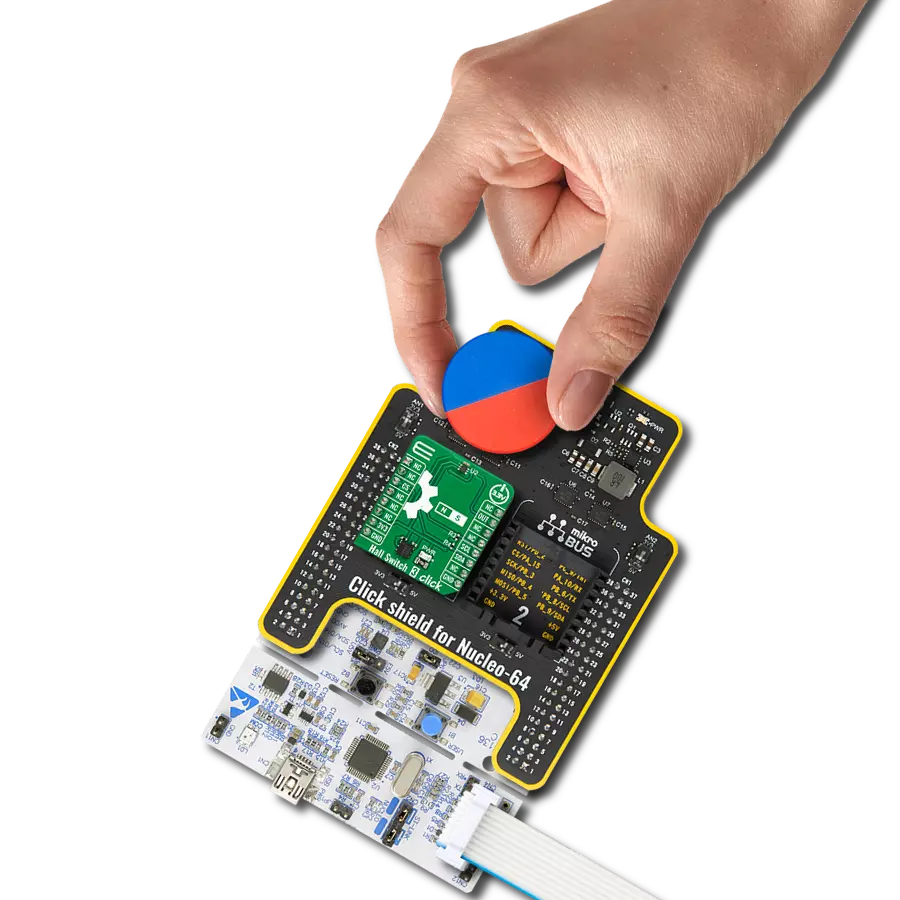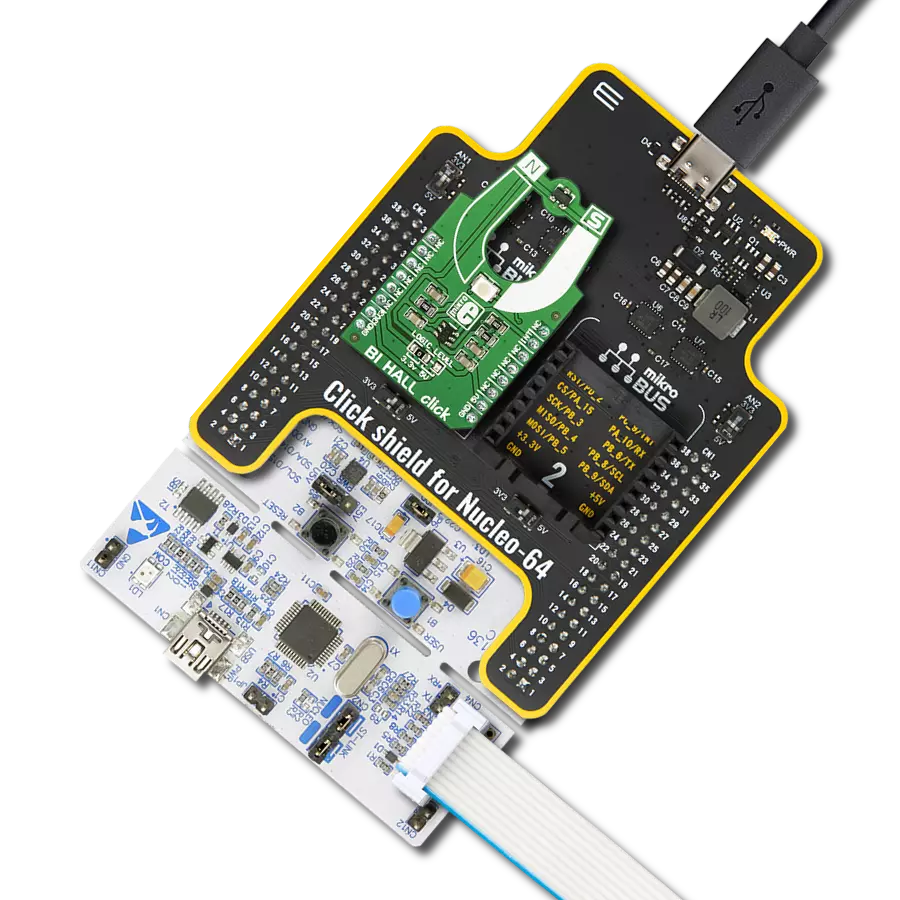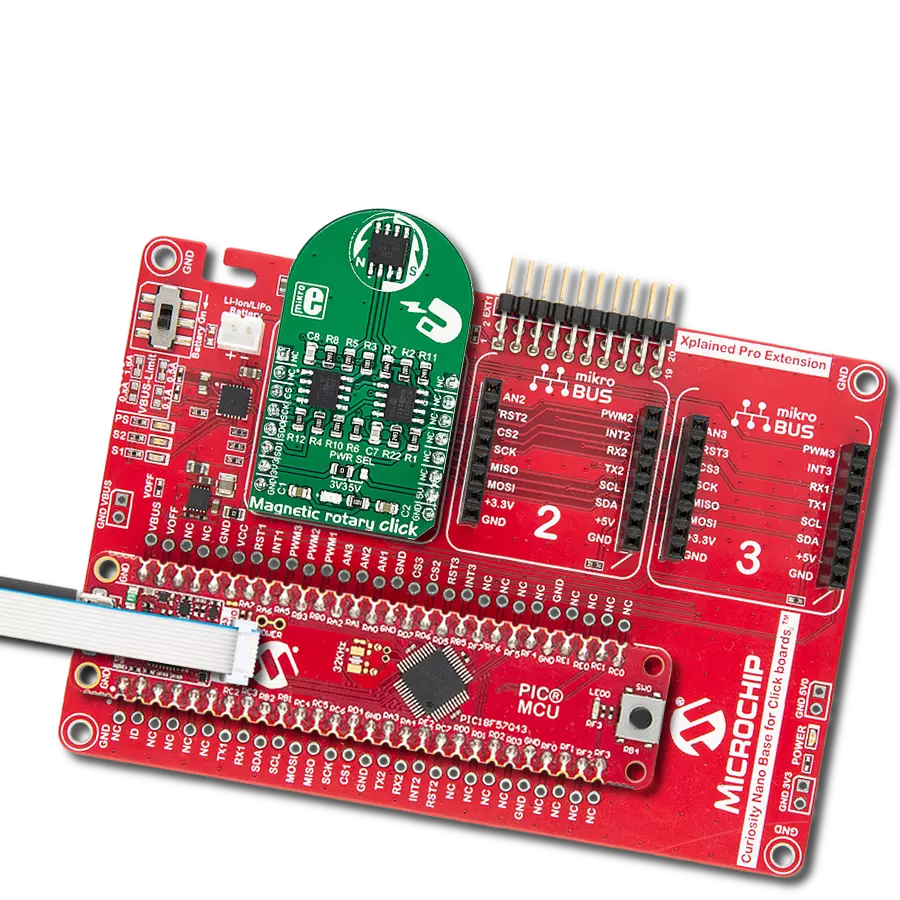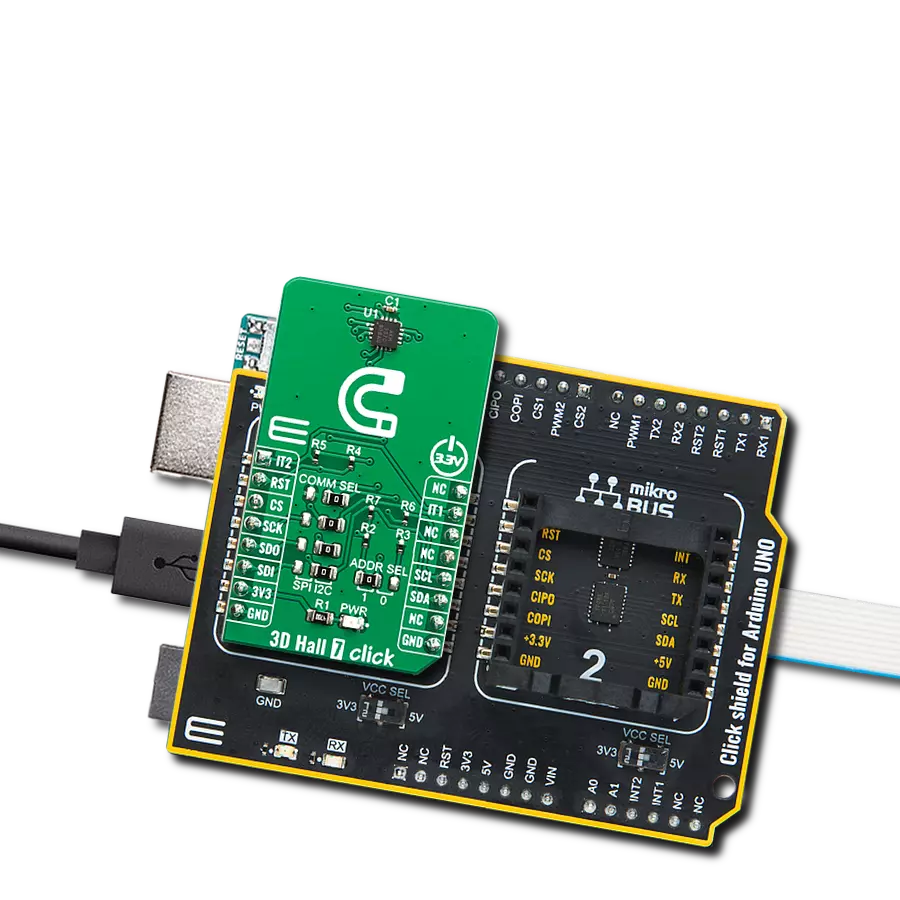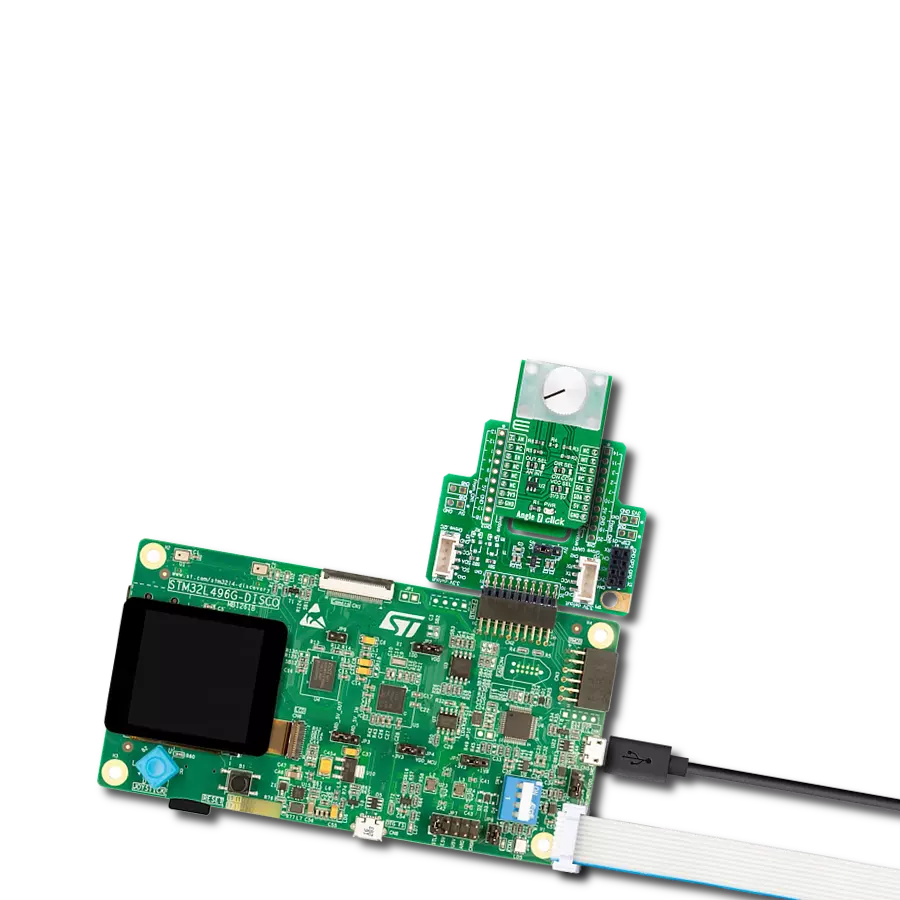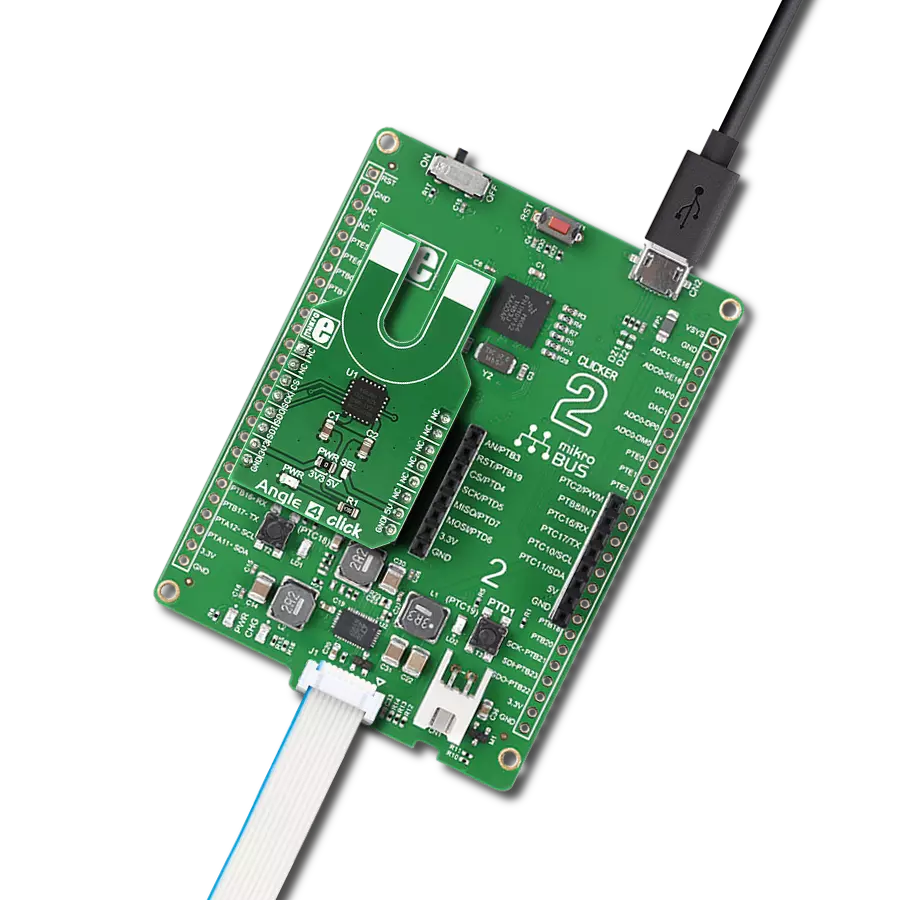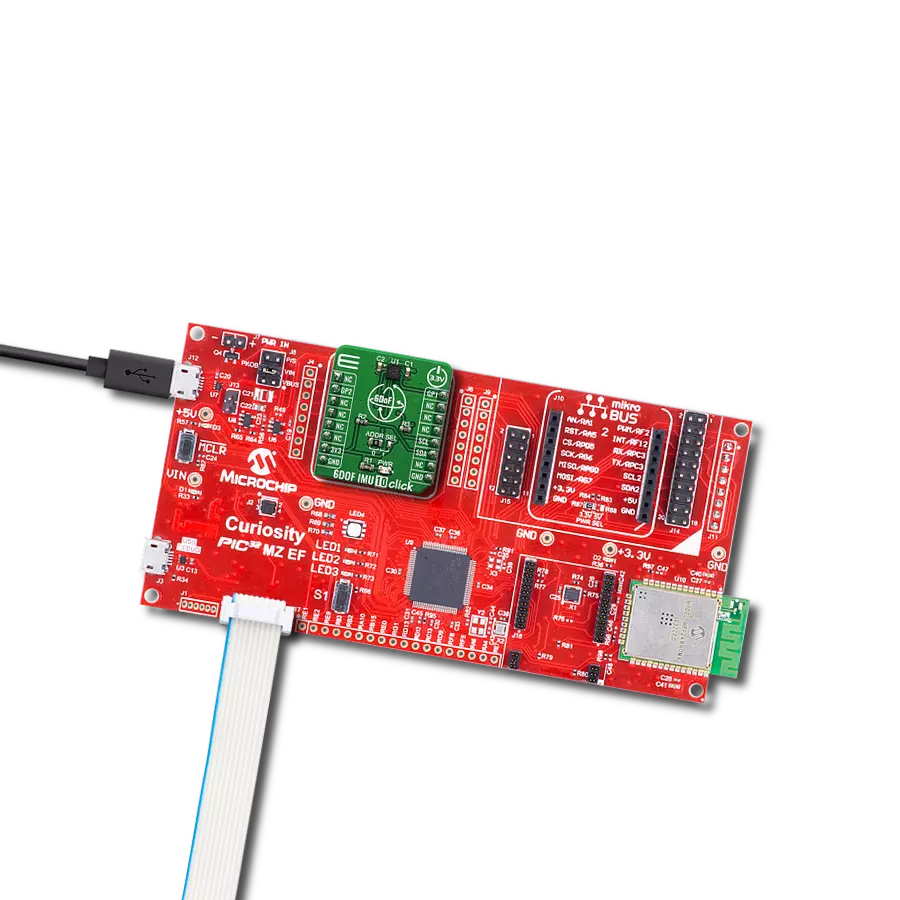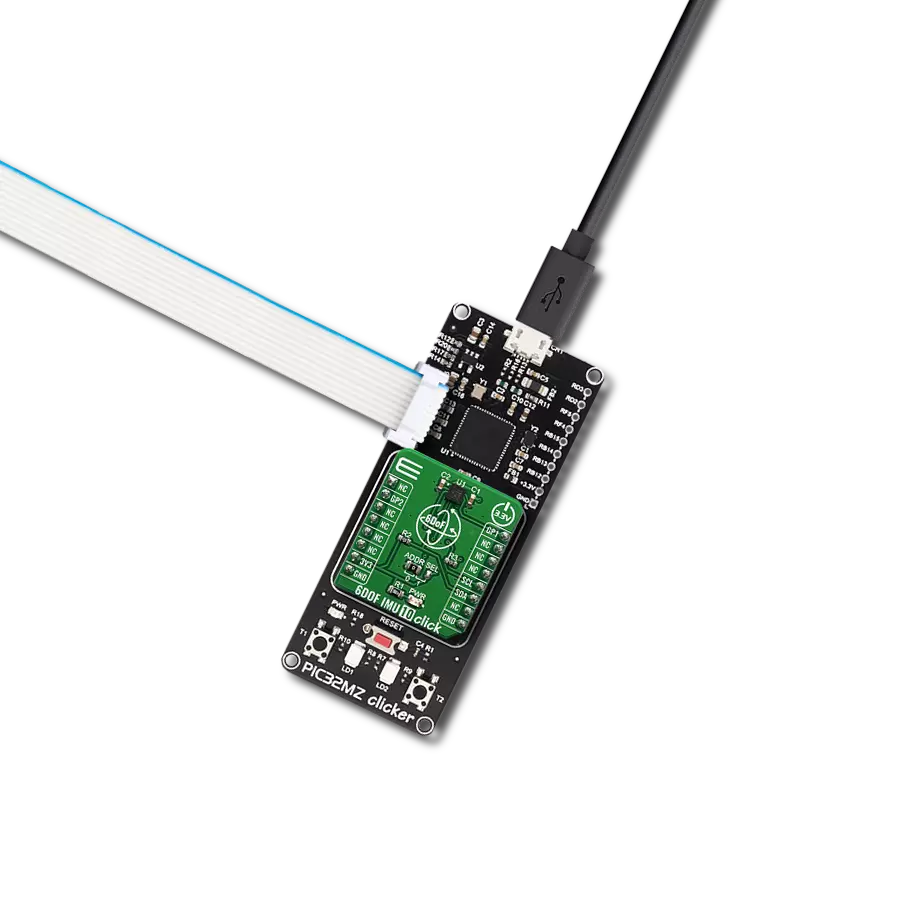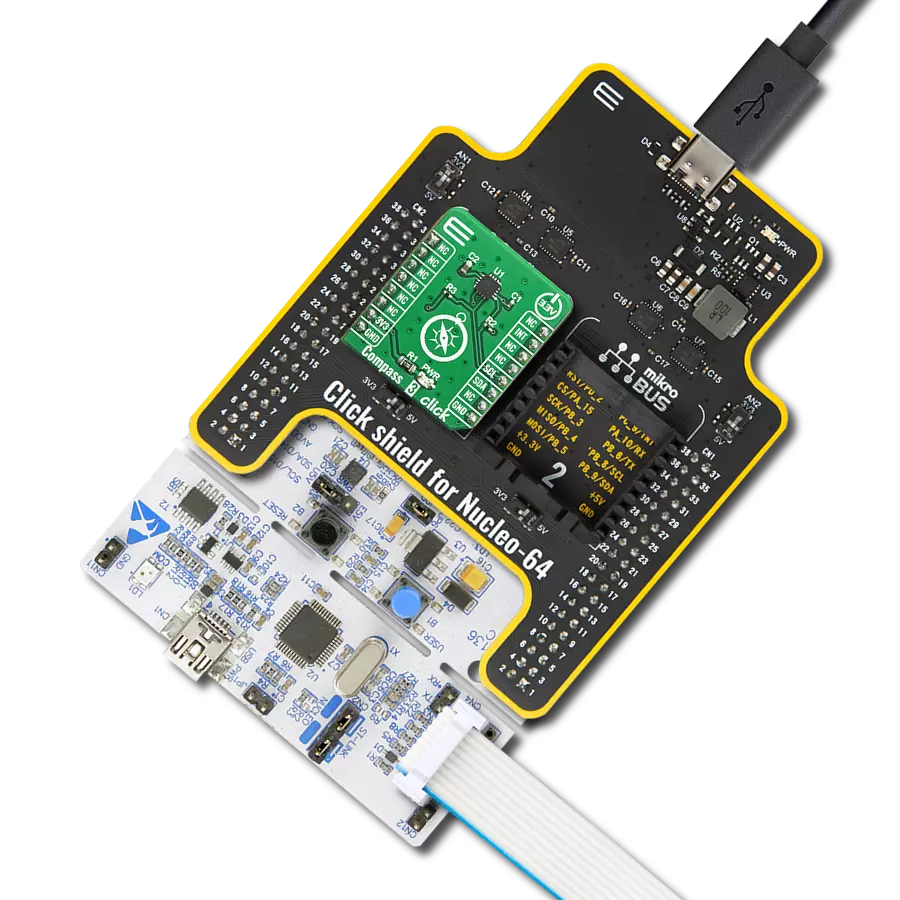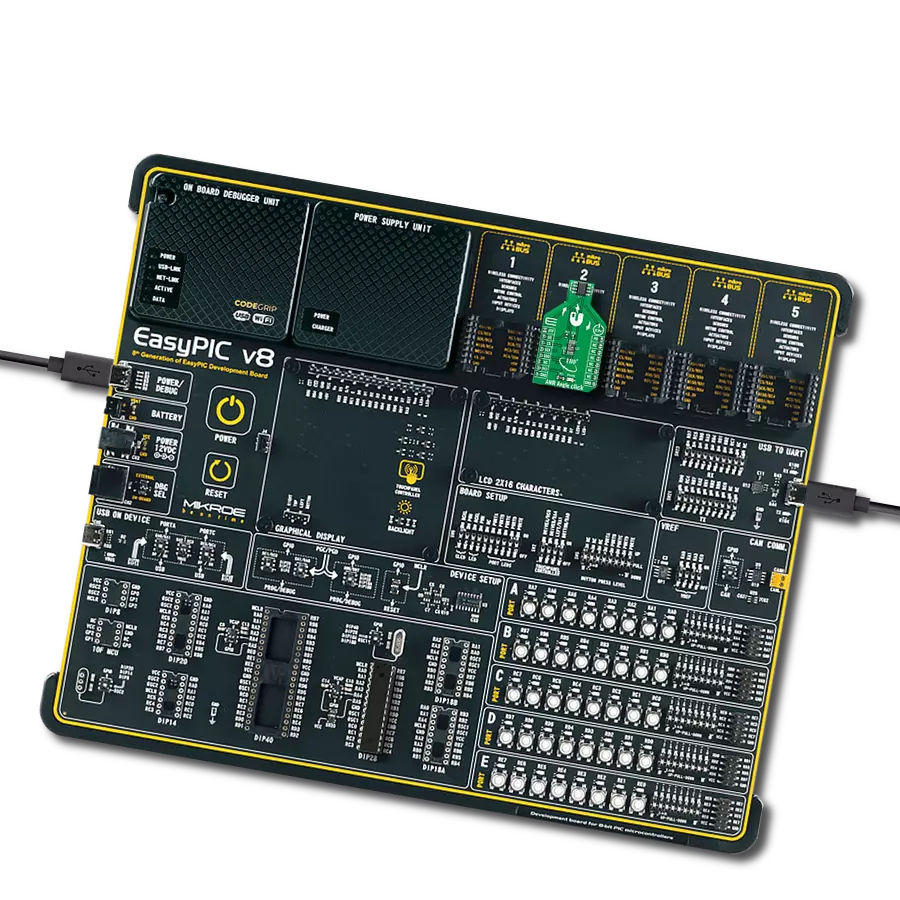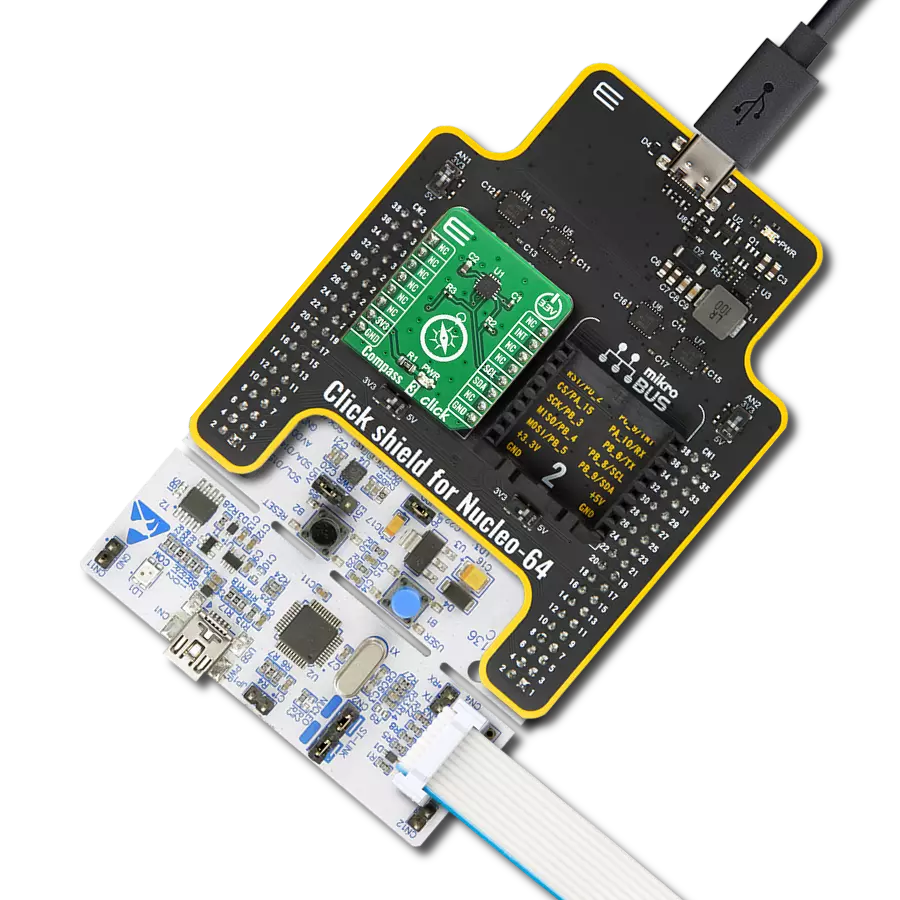Redefine angle measurement with ease using our advanced magnetoresistive technology, delivering precise results through single-ended cosine and sine outputs
A
A
Hardware Overview
How does it work?
MR Angle Click is based on the KMZ60, a high-precision sensor for magnetic angle measurement from NXP Semiconductors. The integrated MR sensor element, a sensitive magnetic field sensor, employs the MR effect of thin-film permalloy. The sensor contains two parallel supplied Wheatstone bridges enclosing a sensitive angle of 45 degrees. A rotating magnetic field in the surface parallel to the chip (x-y plane) will deliver two independent sinusoidal output signals, one following a cosine and the second following a sine function. It also comes with a Power-Down mode to turn on or off the device and a possibility for the temperature coefficient of the sensor amplitude to be compensated. MR Angle Click communicates with MCU through the SPI serial interface using the
MCP3204, a 12-bit 4-channel A/D converter from Microchip. The output sine and cosine signals from the KMZ60 are wired as pseudo-differential input signals to the MCP3204. The MCP3204 samples both sensor channels simultaneously using an SPI interface, allowing access to both channels on one data line. Besides, it possesses additional functionality routed on two GPIO pins, such as Power-Down mode and temperature compensation. The KMZ60 can be used as specified with the temperature compensation of the MR sensor signal. Pin TCE enables the temperature compensation, routed on the RST pin of the mikroBUS™ socket (connected to the ground if no temperature compensation is required). The output signal amplitude will
decrease with increasing temperature related to the temperature compensation of the MR sensor. The Power-Down feature labeled as PDN and routed on the PWM pin of the mikroBUS™ socket switches the device into Power-Down mode and sets the sine and cosine outputs in a high impedance state to avoid current consumption. This Click board™ can operate with either 3.3V or 5V logic voltage levels selected via the VCC SEL jumper. This way, both 3.3V and 5V capable MCUs can use the communication lines properly. Also, this Click board™ comes equipped with a library containing easy-to-use functions and an example code that can be used as a reference for further development.
Features overview
Development board
PIC18F57Q43 Curiosity Nano evaluation kit is a cutting-edge hardware platform designed to evaluate microcontrollers within the PIC18-Q43 family. Central to its design is the inclusion of the powerful PIC18F57Q43 microcontroller (MCU), offering advanced functionalities and robust performance. Key features of this evaluation kit include a yellow user LED and a responsive
mechanical user switch, providing seamless interaction and testing. The provision for a 32.768kHz crystal footprint ensures precision timing capabilities. With an onboard debugger boasting a green power and status LED, programming and debugging become intuitive and efficient. Further enhancing its utility is the Virtual serial port (CDC) and a debug GPIO channel (DGI
GPIO), offering extensive connectivity options. Powered via USB, this kit boasts an adjustable target voltage feature facilitated by the MIC5353 LDO regulator, ensuring stable operation with an output voltage ranging from 1.8V to 5.1V, with a maximum output current of 500mA, subject to ambient temperature and voltage constraints.
Microcontroller Overview
MCU Card / MCU
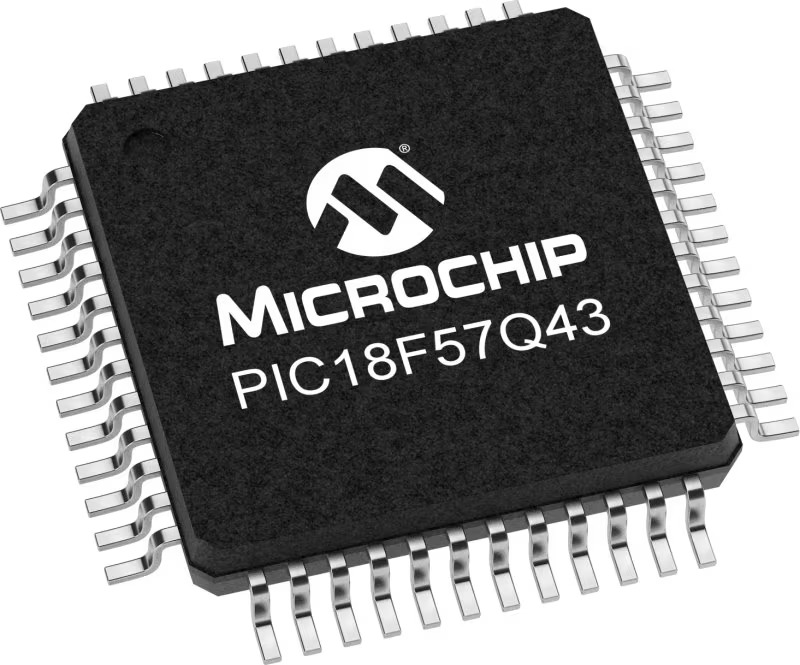
Architecture
PIC
MCU Memory (KB)
128
Silicon Vendor
Microchip
Pin count
48
RAM (Bytes)
8196
You complete me!
Accessories
Curiosity Nano Base for Click boards is a versatile hardware extension platform created to streamline the integration between Curiosity Nano kits and extension boards, tailored explicitly for the mikroBUS™-standardized Click boards and Xplained Pro extension boards. This innovative base board (shield) offers seamless connectivity and expansion possibilities, simplifying experimentation and development. Key features include USB power compatibility from the Curiosity Nano kit, alongside an alternative external power input option for enhanced flexibility. The onboard Li-Ion/LiPo charger and management circuit ensure smooth operation for battery-powered applications, simplifying usage and management. Moreover, the base incorporates a fixed 3.3V PSU dedicated to target and mikroBUS™ power rails, alongside a fixed 5.0V boost converter catering to 5V power rails of mikroBUS™ sockets, providing stable power delivery for various connected devices.
Used MCU Pins
mikroBUS™ mapper
Take a closer look
Click board™ Schematic
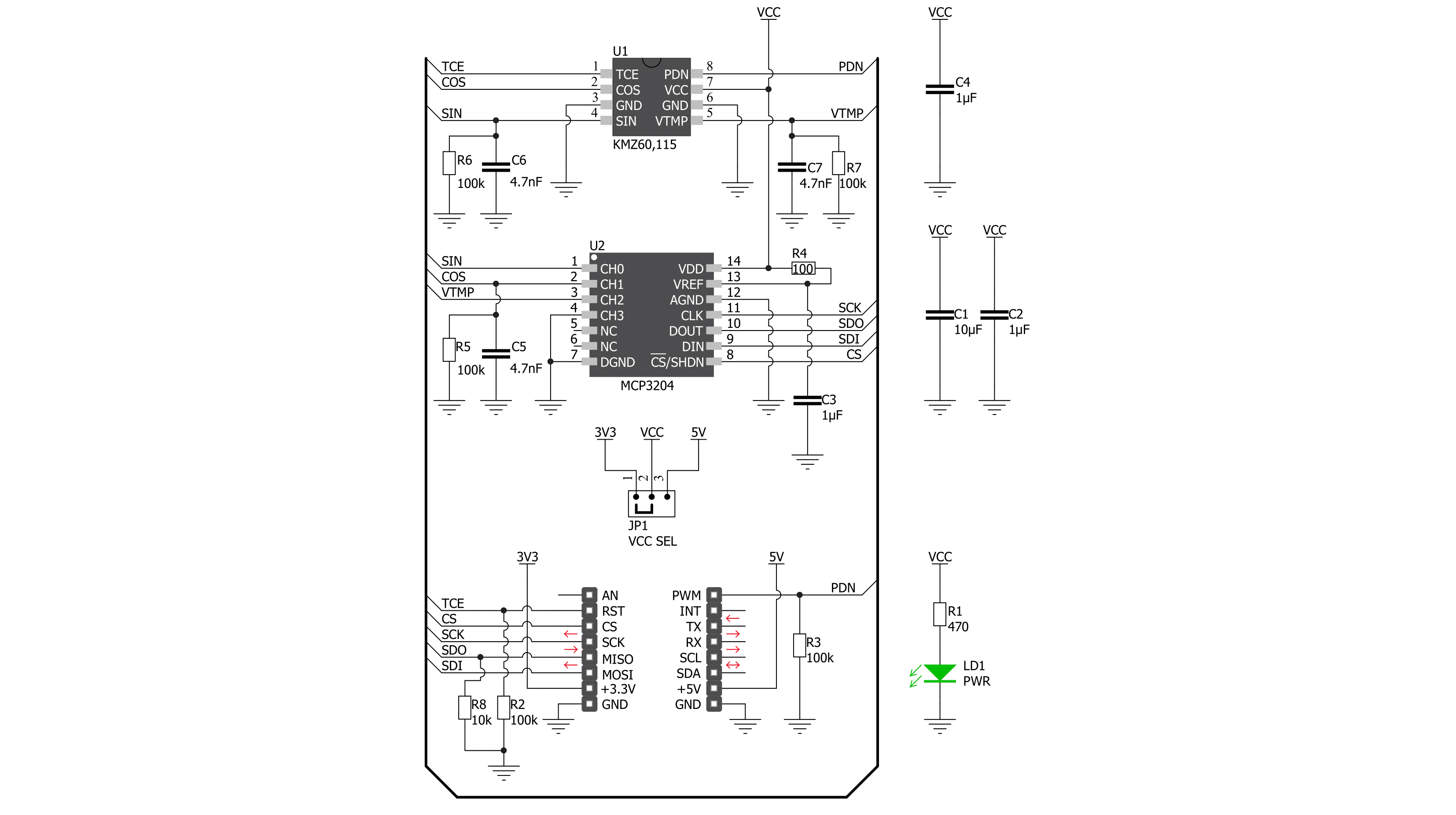
Step by step
Project assembly
Software Support
Library Description
This library contains API for MR Angle Click driver.
Key functions:
mrangle_get_angle- MR Angle get angle functionmrangle_get_temperature- MR Angle get temperature functionmrangle_powerdown_mode- MR Angle powerdown mode function.
Open Source
Code example
The complete application code and a ready-to-use project are available through the NECTO Studio Package Manager for direct installation in the NECTO Studio. The application code can also be found on the MIKROE GitHub account.
/*!
* @file main.c
* @brief MrAngle Click example
*
* # Description
* This library contains API for the MR Angle Click driver.
* This demo application shows an example of angle measurement.
*
* The demo application is composed of two sections :
*
* ## Application Init
* Initialization of SPI module and log UART.
* After driver initialization, the app performs default settings.
*
* ## Application Task
* This is an example that shows the use of an MR Angle Click board™.
* The application task consists of reading the angle measurements in degrees ( 0 - 180 ).
* Results are being sent to the Usart Terminal where you can track their changes.
*
* @author Nenad Filipovic
*
*/
#include "board.h"
#include "log.h"
#include "mrangle.h"
static mrangle_t mrangle;
static log_t logger;
static float angle;
void application_init ( void )
{
log_cfg_t log_cfg; /**< Logger config object. */
mrangle_cfg_t mrangle_cfg; /**< Click config object. */
/**
* Logger initialization.
* Default baud rate: 115200
* Default log level: LOG_LEVEL_DEBUG
* @note If USB_UART_RX and USB_UART_TX
* are defined as HAL_PIN_NC, you will
* need to define them manually for log to work.
* See @b LOG_MAP_USB_UART macro definition for detailed explanation.
*/
LOG_MAP_USB_UART( log_cfg );
log_init( &logger, &log_cfg );
log_info( &logger, " Application Init " );
// Click initialization.
mrangle_cfg_setup( &mrangle_cfg );
MRANGLE_MAP_MIKROBUS( mrangle_cfg, MIKROBUS_1 );
if ( SPI_MASTER_ERROR == mrangle_init( &mrangle, &mrangle_cfg ) )
{
log_error( &logger, " Application Init Error. " );
log_info( &logger, " Please, run program again... " );
for ( ; ; );
}
mrangle_default_cfg ( &mrangle );
log_info( &logger, " Application Task " );
}
void application_task ( void )
{
mrangle_get_angle( &mrangle, &angle );
log_printf( &logger, " Angle: %.2f deg\r\n", angle );
log_printf( &logger, "------------------\r\n" );
Delay_ms ( 1000 );
}
int main ( void )
{
/* Do not remove this line or clock might not be set correctly. */
#ifdef PREINIT_SUPPORTED
preinit();
#endif
application_init( );
for ( ; ; )
{
application_task( );
}
return 0;
}
// ------------------------------------------------------------------------ END
Additional Support
Resources
Category:Magnetic




















